Attached files
| file | filename |
|---|---|
| EX-99.2 - EX-99.2 - Ocugen, Inc. | d605930dex992.htm |
| 8-K - 8-K - Ocugen, Inc. | d605930d8k.htm |
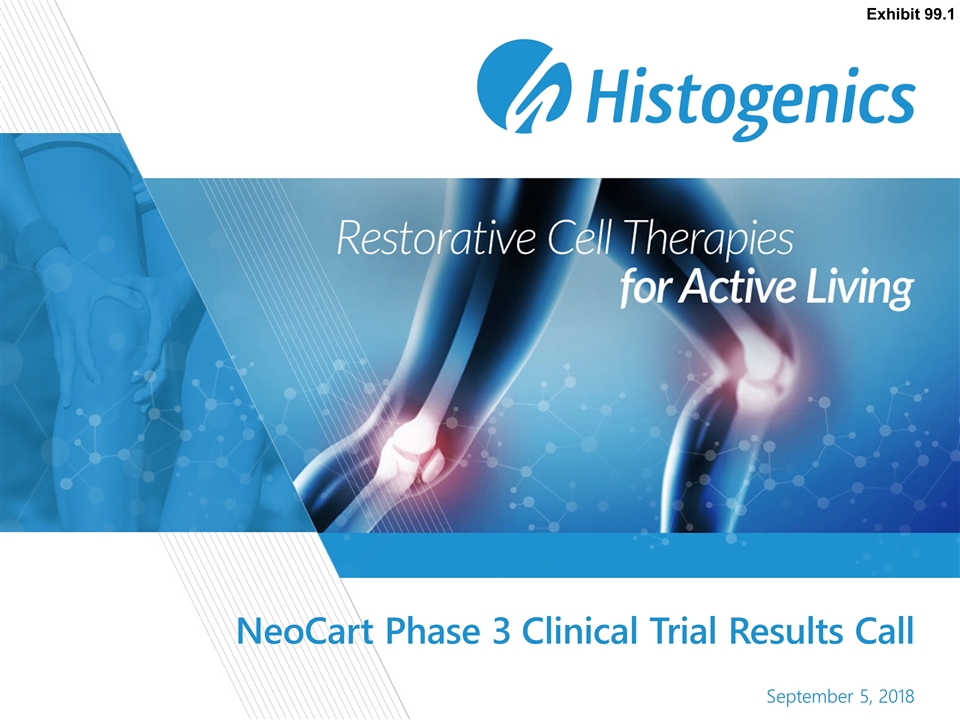
NeoCart Phase 3 Clinical Trial Results Call September 5, 2018 Exhibit 99.1
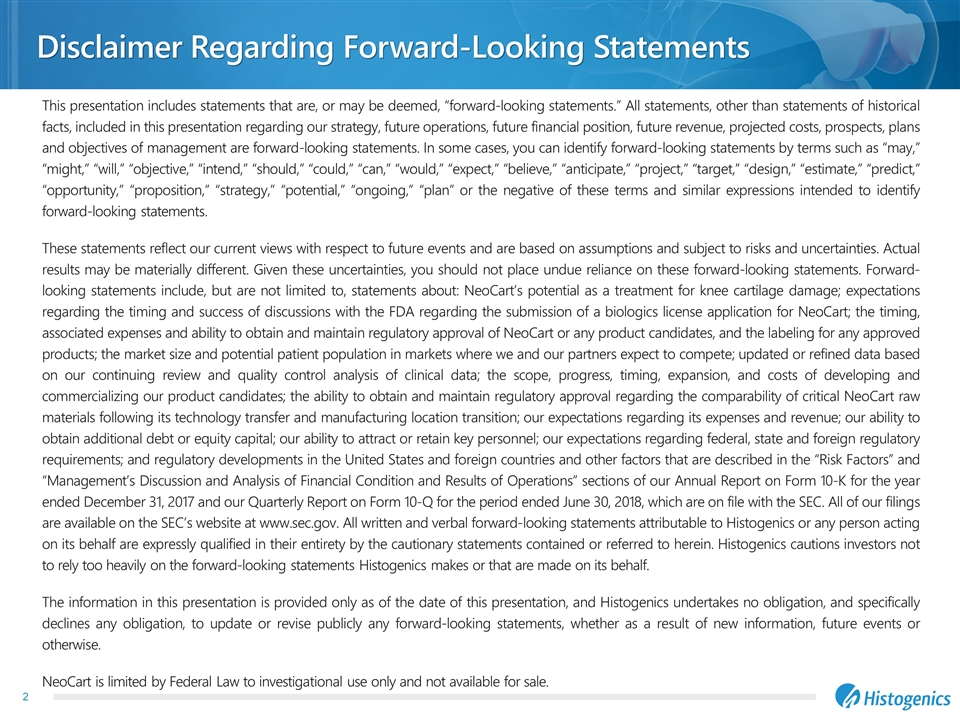
Disclaimer Regarding Forward-Looking Statements This presentation includes statements that are, or may be deemed, “forward-looking statements.” All statements, other than statements of historical facts, included in this presentation regarding our strategy, future operations, future financial position, future revenue, projected costs, prospects, plans and objectives of management are forward-looking statements. In some cases, you can identify forward-looking statements by terms such as “may,” “might,” “will,” “objective,” “intend,” “should,” “could,” “can,” “would,” “expect,” “believe,” “anticipate,” “project,” “target,” “design,” “estimate,” “predict,” “opportunity,” “proposition,” “strategy,” “potential,” “ongoing,” “plan” or the negative of these terms and similar expressions intended to identify forward-looking statements. These statements reflect our current views with respect to future events and are based on assumptions and subject to risks and uncertainties. Actual results may be materially different. Given these uncertainties, you should not place undue reliance on these forward-looking statements. Forward-looking statements include, but are not limited to, statements about: NeoCart’s potential as a treatment for knee cartilage damage; expectations regarding the timing and success of discussions with the FDA regarding the submission of a biologics license application for NeoCart; the timing, associated expenses and ability to obtain and maintain regulatory approval of NeoCart or any product candidates, and the labeling for any approved products; the market size and potential patient population in markets where we and our partners expect to compete; updated or refined data based on our continuing review and quality control analysis of clinical data; the scope, progress, timing, expansion, and costs of developing and commercializing our product candidates; the ability to obtain and maintain regulatory approval regarding the comparability of critical NeoCart raw materials following its technology transfer and manufacturing location transition; our expectations regarding its expenses and revenue; our ability to obtain additional debt or equity capital; our ability to attract or retain key personnel; our expectations regarding federal, state and foreign regulatory requirements; and regulatory developments in the United States and foreign countries and other factors that are described in the “Risk Factors” and “Management’s Discussion and Analysis of Financial Condition and Results of Operations” sections of our Annual Report on Form 10-K for the year ended December 31, 2017 and our Quarterly Report on Form 10-Q for the period ended June 30, 2018, which are on file with the SEC. All of our filings are available on the SEC’s website at www.sec.gov. All written and verbal forward-looking statements attributable to Histogenics or any person acting on its behalf are expressly qualified in their entirety by the cautionary statements contained or referred to herein. Histogenics cautions investors not to rely too heavily on the forward-looking statements Histogenics makes or that are made on its behalf. The information in this presentation is provided only as of the date of this presentation, and Histogenics undertakes no obligation, and specifically declines any obligation, to update or revise publicly any forward-looking statements, whether as a result of new information, future events or otherwise. NeoCart is limited by Federal Law to investigational use only and not available for sale.

Agenda Executive Summary History – Regulatory Guidance and Clinical Trial Design, Comparators & Current Standards Phase 3 Clinical Trial Design & Demographics Overview of Dual Threshold Responder Analysis Dual Threshold Data Review Current FDA Guidelines for Clinical Trials Current Guidelines Data Review Conclusion & Next Steps

Summary of NeoCart Phase 3 Clinical Trial Results NeoCart demonstrated clinically meaningful improvement at 1 year vs. microfracture on highest hurdle, dual-threshold endpoint. The trial narrowly missed statistical significance and did not meet the primary endpoint by 2 microfracture responders in the mITT population (one sided test: *p=0.025). 62% of NeoCart patients were responders at 6 months vs 46% of microfracture (*p=0.0188). 74% of NeoCart patients were responders at 1 year vs 62% of microfracture (p=0.0714). Based on current MCID on IKDC for example, NeoCart demonstrated statistically significantly superiority. NeoCart demonstrated statistically significant results compared to microfracture at 1 year on KOOS and IKDC endpoints, as established in FDA Guidance & used in ongoing clinical trials conducted by third parties. It also demonstrated superiority at 2 years based on only ~120 patients (visits pending for rest). NeoCart performed better than expected, demonstrating early and sustained clinically meaningful improvements at 1 year and 2 years. However, microfracture did better than expected in what we believe is the most robust study conducted to date under current FDA guidance in a population intended to maximize its performance (low BMI, most appropriate lesion size and strict rehabilitation program). Risk / benefit believed to be established, safety between arms was comparable. Based on totality of data and published FDA guidelines, we believe NeoCart should be acceptable for review and potential approval. We intend to confirm this with the FDA via a Type A Meeting.
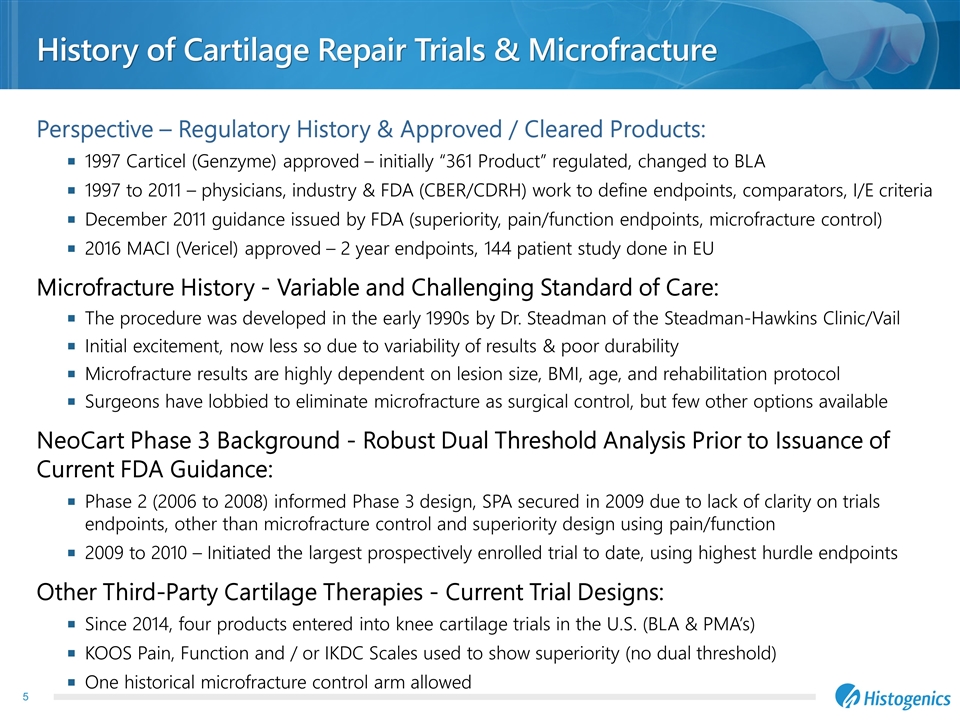
History of Cartilage Repair Trials & Microfracture Perspective – Regulatory History & Approved / Cleared Products: 1997 Carticel (Genzyme) approved – initially “361 Product” regulated, changed to BLA 1997 to 2011 – physicians, industry & FDA (CBER/CDRH) work to define endpoints, comparators, I/E criteria December 2011 guidance issued by FDA (superiority, pain/function endpoints, microfracture control) 2016 MACI (Vericel) approved – 2 year endpoints, 144 patient study done in EU Microfracture History - Variable and Challenging Standard of Care: The procedure was developed in the early 1990s by Dr. Steadman of the Steadman-Hawkins Clinic/Vail Initial excitement, now less so due to variability of results & poor durability Microfracture results are highly dependent on lesion size, BMI, age, and rehabilitation protocol Surgeons have lobbied to eliminate microfracture as surgical control, but few other options available NeoCart Phase 3 Background - Robust Dual Threshold Analysis Prior to Issuance of Current FDA Guidance: Phase 2 (2006 to 2008) informed Phase 3 design, SPA secured in 2009 due to lack of clarity on trials endpoints, other than microfracture control and superiority design using pain/function 2009 to 2010 – Initiated the largest prospectively enrolled trial to date, using highest hurdle endpoints Other Third-Party Cartilage Therapies - Current Trial Designs: Since 2014, four products entered into knee cartilage trials in the U.S. (BLA & PMA’s) KOOS Pain, Function and / or IKDC Scales used to show superiority (no dual threshold) One historical microfracture control arm allowed
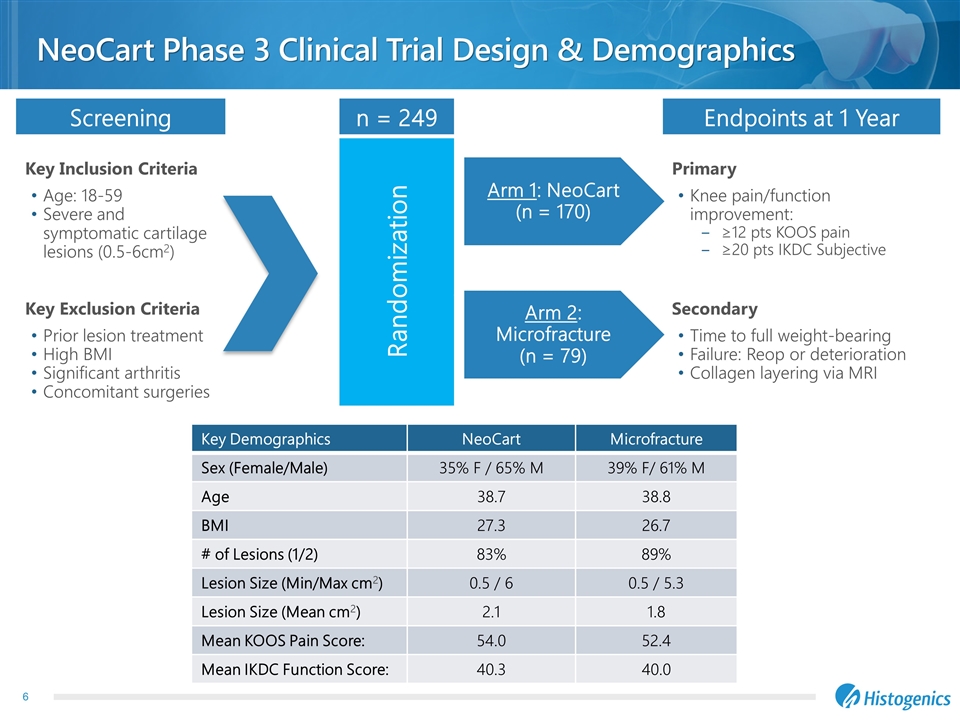
NeoCart Phase 3 Clinical Trial Design & Demographics Screening n = 249 Endpoints at 1 Year Key Inclusion Criteria Age: 18-59 Severe and symptomatic cartilage lesions (0.5-6cm2) Randomization Primary Knee pain/function improvement: ≥12 pts KOOS pain ≥20 pts IKDC Subjective Key Exclusion Criteria Prior lesion treatment High BMI Significant arthritis Concomitant surgeries Secondary Time to full weight-bearing Failure: Reop or deterioration Collagen layering via MRI Arm 1: NeoCart (n = 170) Arm 2: Microfracture (n = 79) Key Demographics NeoCart Microfracture Sex (Female/Male) 35% F / 65% M 39% F/ 61% M Age 38.7 38.8 BMI 27.3 26.7 # of Lesions (1/2) 83% 89% Lesion Size (Min/Max cm2) 0.5 / 6 0.5 / 5.3 Lesion Size (Mean cm2) 2.1 1.8 Mean KOOS Pain Score: 54.0 52.4 Mean IKDC Function Score: 40.3 40.0

Dual Threshold : Reasons for Its Use, Design & Impact Dual Threshold Responders typically used in Oncology or Cardiology to further demonstrate magnitudes of clinically relevant effects. When our trial was designed in 2009 (prior to FDA guidance released in 2011), it had been rarely used in Orthopedics, particularly with patient reported outcome endpoints. Initial thesis: true leveler design to modulate the tendency for patients to accommodate pain or loss of function. Goal is to show that each patient gets better on both scores vs. mean differences on individual scores. Minimum clinically important/meaningful differences or cut-off’s have greater impact than in other designs – balance of specificity and sensitivity.
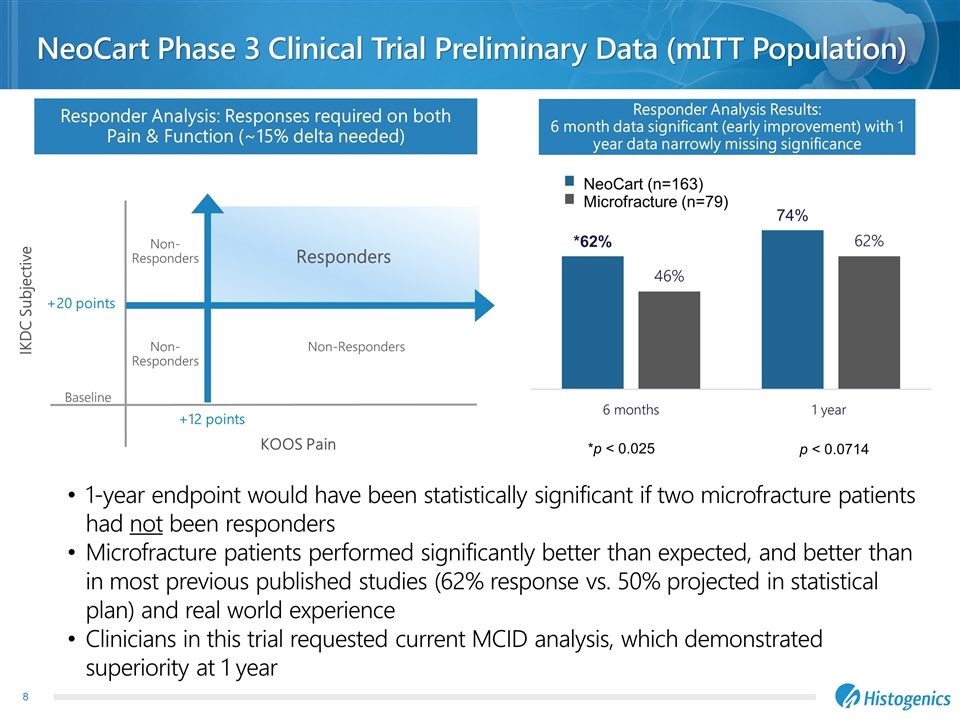
NeoCart Phase 3 Clinical Trial Preliminary Data (mITT Population) *p < 0.025 NeoCart (n=163) Microfracture (n=79) Responder Analysis Results: 6 month data significant (early improvement) with 1 year data narrowly missing significance Responders Non-Responders Non- Responders Non- Responders +12 points +20 points IKDC Subjective KOOS Pain Baseline Responder Analysis: Responses required on both Pain & Function (~15% delta needed) 1-year endpoint would have been statistically significant if two microfracture patients had not been responders Microfracture patients performed significantly better than expected, and better than in most previous published studies (62% response vs. 50% projected in statistical plan) and real world experience Clinicians in this trial requested current MCID analysis, which demonstrated superiority at 1 year p < 0.0714
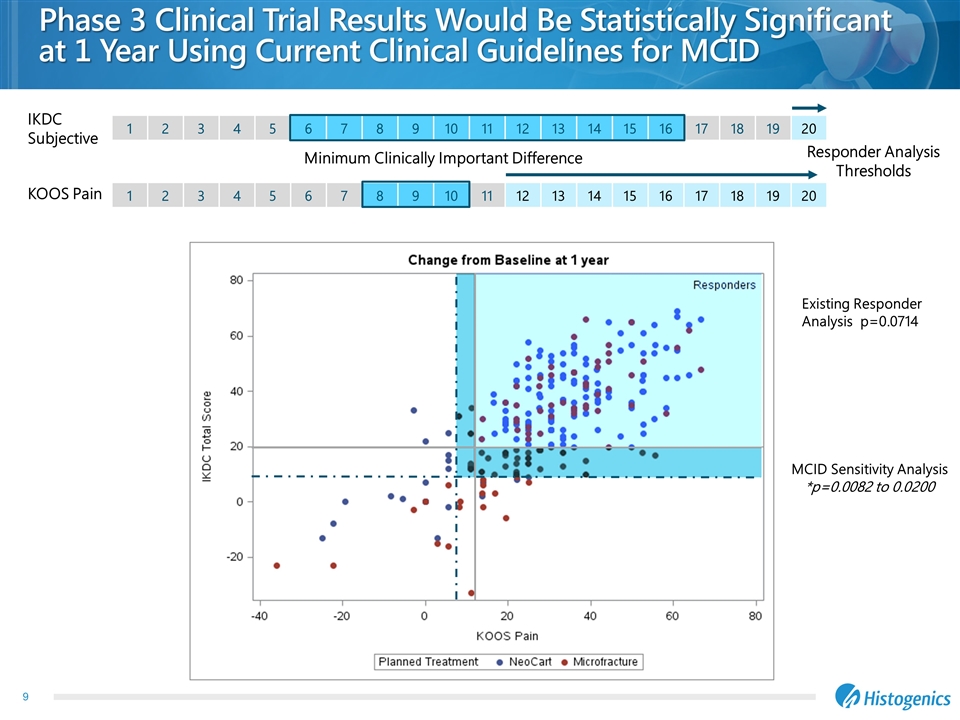
Phase 3 Clinical Trial Results Would Be Statistically Significant at 1 Year Using Current Clinical Guidelines for MCID 1 2 3 4 5 6 7 8 9 10 11 12 13 14 15 16 17 18 19 20 1 2 3 4 5 6 7 8 9 10 11 12 13 14 15 16 17 18 19 20 Minimum Clinically Important Difference IKDC Subjective KOOS Pain Responder Analysis Thresholds Existing Responder Analysis p=0.0714 MCID Sensitivity Analysis *p=0.0082 to 0.0200

1-Year Dual Threshold Endpoint: Patient Populations & Observations Other Important Responder Observations: In BMI >28: NeoCart 78% response rate vs 48% for microfracture (*p= 0.0168) In > 2.2 cm lesions: NeoCart 76% response rate vs 52% for microfracture (*p= 0.0145) In two lesions: NeoCart 85% response rate vs 43% for microfracture (p=0.0418) Failure Observations (% of patients at 1 year with scores below baseline) IKDC: 2.5% for NeoCart; 12.7% for microfracture KOOS: 3.7% for NeoCart; 3.7% for microfracture BOTH: 1.2% for NeoCart; 3.8% for microfracture NeoCart (N=170) Microfracture (N=79) Change Positive Responders Responder Rate Positive Responders Responder Rate Difference p value: Intent to Treat (ITT) 121/170 71.2% 49/79 62.0% 9.2 p=0.1877 Modified ITT (mITT) 121/163 74.2% 49/79 62.0% 12.2 P=0.0714 As Treated (AT) 120/162 74.1% 50/80 62.5% 11.6 p=0.0735 Per Protocol (PP) 118/155 76.1% 43/65 66.2% 10.0 p=0.1362 Patient Populations (all analyses on mITT):
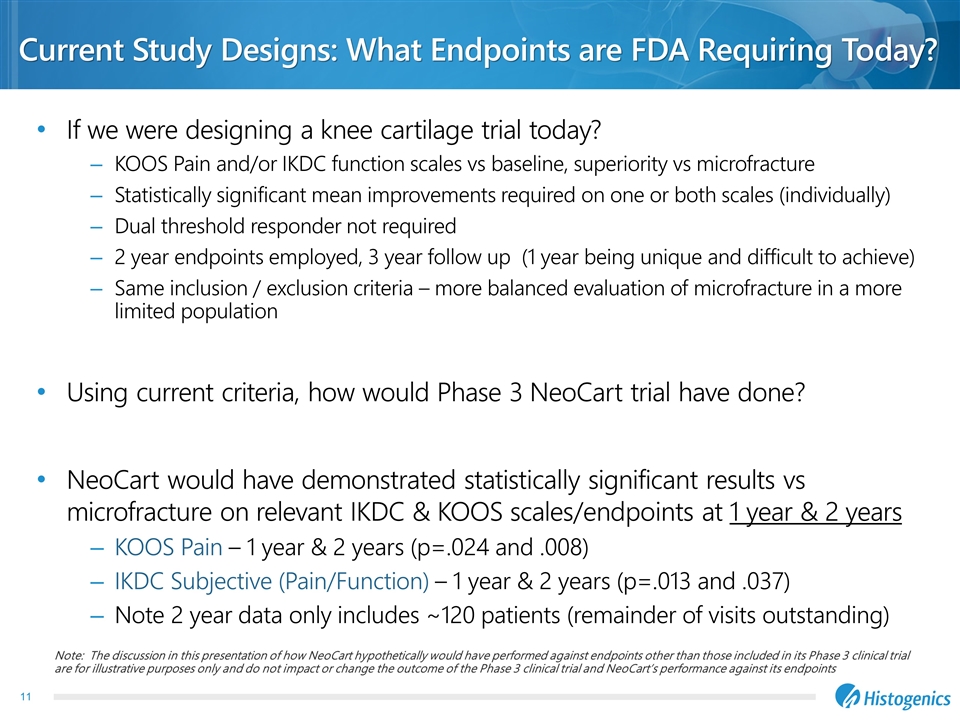
Current Study Designs: What Endpoints are FDA Requiring Today? If we were designing a knee cartilage trial today? KOOS Pain and/or IKDC function scales vs baseline, superiority vs microfracture Statistically significant mean improvements required on one or both scales (individually) Dual threshold responder not required 2 year endpoints employed, 3 year follow up (1 year being unique and difficult to achieve) Same inclusion / exclusion criteria – more balanced evaluation of microfracture in a more limited population Using current criteria, how would Phase 3 NeoCart trial have done? NeoCart would have demonstrated statistically significant results vs microfracture on relevant IKDC & KOOS scales/endpoints at 1 year & 2 years KOOS Pain – 1 year & 2 years (p=.024 and .008) IKDC Subjective (Pain/Function) – 1 year & 2 years (p=.013 and .037) Note 2 year data only includes ~120 patients (remainder of visits outstanding) Note: The discussion in this presentation of how NeoCart hypothetically would have performed against endpoints other than those included in its Phase 3 clinical trial are for illustrative purposes only and do not impact or change the outcome of the Phase 3 clinical trial and NeoCart’s performance against its endpoints
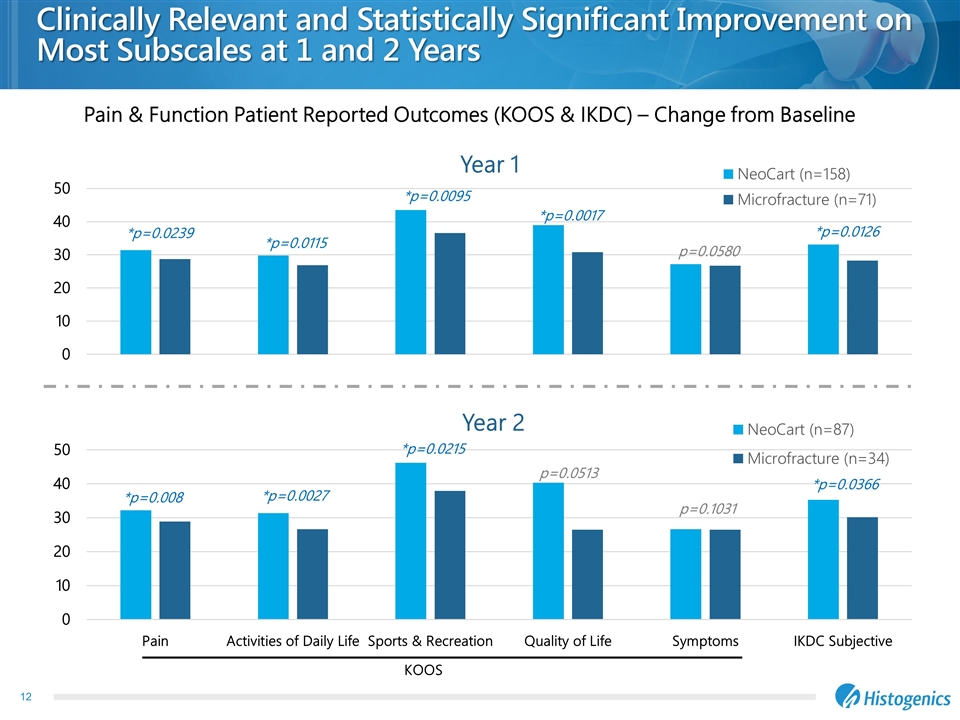
Clinically Relevant and Statistically Significant Improvement on Most Subscales at 1 and 2 Years KOOS *p=0.0239 *p=0.0115 *p=0.0095 *p=0.0017 p=0.0580 *p=0.0126 Year 1 Year 2 *p=0.008 *p=0.0027 *p=0.0215 p=0.0513 p=0.1031 *p=0.0366 Pain & Function Patient Reported Outcomes (KOOS & IKDC) – Change from Baseline
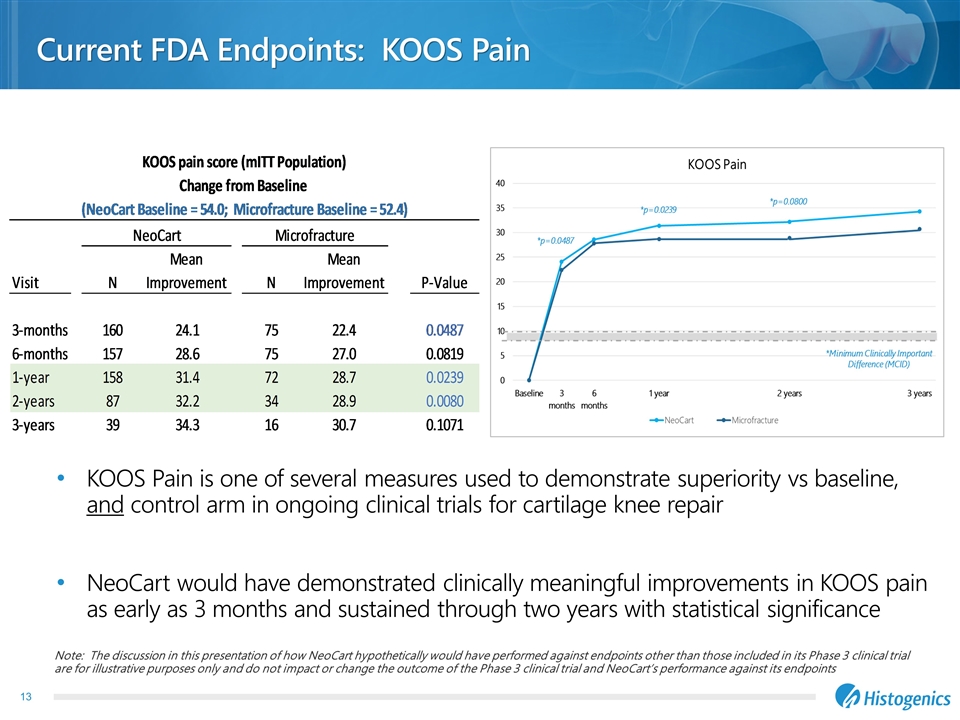
Current FDA Endpoints: KOOS Pain KOOS Pain is one of several measures used to demonstrate superiority vs baseline, and control arm in ongoing clinical trials for cartilage knee repair NeoCart would have demonstrated clinically meaningful improvements in KOOS pain as early as 3 months and sustained through two years with statistical significance Note: The discussion in this presentation of how NeoCart hypothetically would have performed against endpoints other than those included in its Phase 3 clinical trial are for illustrative purposes only and do not impact or change the outcome of the Phase 3 clinical trial and NeoCart’s performance against its endpoints
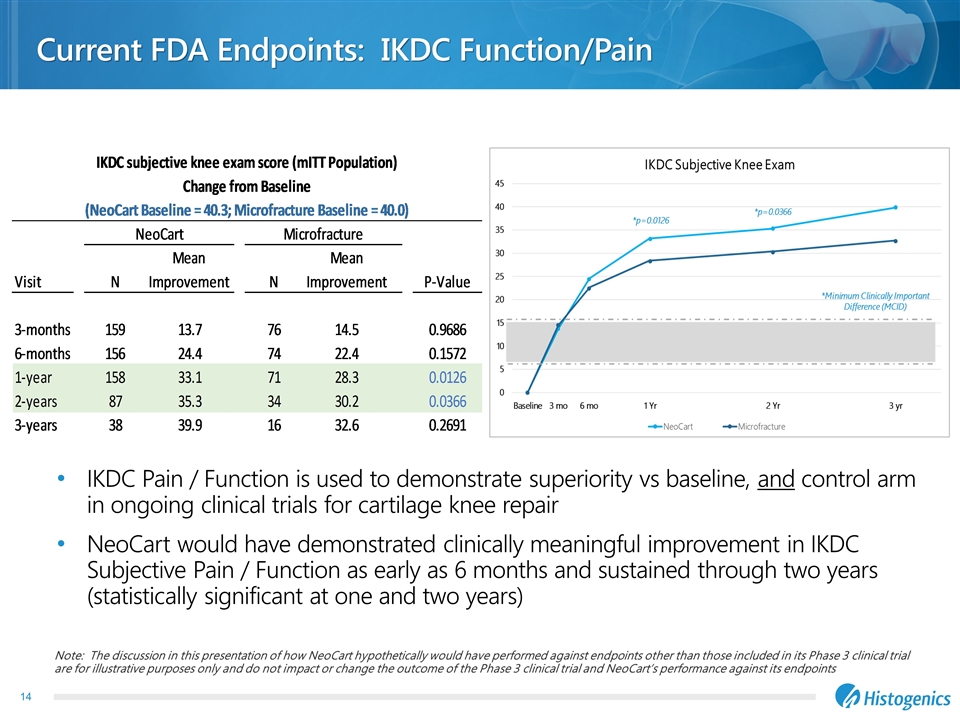
Current FDA Endpoints: IKDC Function/Pain IKDC Pain / Function is used to demonstrate superiority vs baseline, and control arm in ongoing clinical trials for cartilage knee repair NeoCart would have demonstrated clinically meaningful improvement in IKDC Subjective Pain / Function as early as 6 months and sustained through two years (statistically significant at one and two years) Note: The discussion in this presentation of how NeoCart hypothetically would have performed against endpoints other than those included in its Phase 3 clinical trial are for illustrative purposes only and do not impact or change the outcome of the Phase 3 clinical trial and NeoCart’s performance against its endpoints

Key Conclusions & Next Steps Based on the totality of the data at 6 months, 1 year, and 2 years, we believe NeoCart has demonstrated superior clinically meaningful results. Risk / Benefits: Safety profile of NeoCart was comparable, with data that were superior to standard of care. Clinicians who have used NeoCart believe this product could be a market leading therapy, if approved. We are requesting meeting with FDA to discuss our BLA filing strategy, and if granted, would expect feedback in October 2018. Based on expert feedback, we believe the data supports FDA review & potential FDA approval, without considerable impact to timelines. Assuming BLA filed & accepted, targeting early 2020 NeoCart launch, if approved.
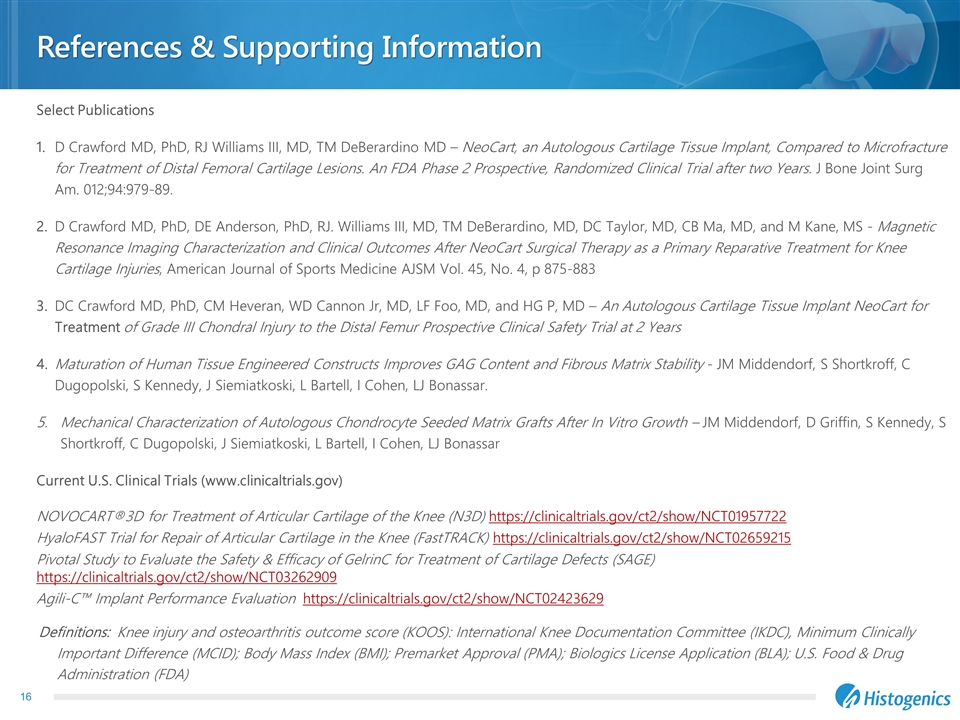
References & Supporting Information Select Publications 1.D Crawford MD, PhD, RJ Williams III, MD, TM DeBerardino MD – NeoCart, an Autologous Cartilage Tissue Implant, Compared to Microfracture for Treatment of Distal Femoral Cartilage Lesions. An FDA Phase 2 Prospective, Randomized Clinical Trial after two Years. J Bone Joint Surg Am. 012;94:979-89. 2.D Crawford MD, PhD, DE Anderson, PhD, RJ. Williams III, MD, TM DeBerardino, MD, DC Taylor, MD, CB Ma, MD, and M Kane, MS - Magnetic Resonance Imaging Characterization and Clinical Outcomes After NeoCart Surgical Therapy as a Primary Reparative Treatment for Knee Cartilage Injuries, American Journal of Sports Medicine AJSM Vol. 45, No. 4, p 875-883 3.DC Crawford MD, PhD, CM Heveran, WD Cannon Jr, MD, LF Foo, MD, and HG P, MD – An Autologous Cartilage Tissue Implant NeoCart for Treatment of Grade III Chondral Injury to the Distal Femur Prospective Clinical Safety Trial at 2 Years 4.Maturation of Human Tissue Engineered Constructs Improves GAG Content and Fibrous Matrix Stability - JM Middendorf, S Shortkroff, C Dugopolski, S Kennedy, J Siemiatkoski, L Bartell, I Cohen, LJ Bonassar. Mechanical Characterization of Autologous Chondrocyte Seeded Matrix Grafts After In Vitro Growth – JM Middendorf, D Griffin, S Kennedy, S Shortkroff, C Dugopolski, J Siemiatkoski, L Bartell, I Cohen, LJ Bonassar Current U.S. Clinical Trials (www.clinicaltrials.gov) NOVOCART®3D for Treatment of Articular Cartilage of the Knee (N3D) https://clinicaltrials.gov/ct2/show/NCT01957722 HyaloFAST Trial for Repair of Articular Cartilage in the Knee (FastTRACK) https://clinicaltrials.gov/ct2/show/NCT02659215 Pivotal Study to Evaluate the Safety & Efficacy of GelrinC for Treatment of Cartilage Defects (SAGE) https://clinicaltrials.gov/ct2/show/NCT03262909 Agili-C™ Implant Performance Evaluation https://clinicaltrials.gov/ct2/show/NCT02423629 Definitions: Knee injury and osteoarthritis outcome score (KOOS): International Knee Documentation Committee (IKDC), Minimum Clinically Important Difference (MCID); Body Mass Index (BMI); Premarket Approval (PMA); Biologics License Application (BLA); U.S. Food & Drug Administration (FDA)
